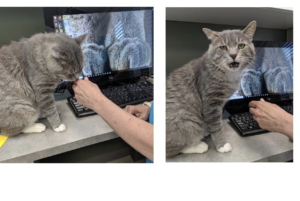What does my cat smell?
Cats live in a landscape of odors. Odors tell them about their world and carry messages from other cats.
Cats have two ways of detecting odors in their environment: the cells lining the nose and nasal cavity and the vomeronasal organ (VNO or Jacobson’s organ). The VNO consists of two fluid-filled sacs located in the roof of the cat’s mouth that connect to the nasal cavity as well as the mouth. Molecules dissolved in the nasal mucus or saliva can be sucked into the VNO.
Sometimes, you will see a cat with its mouth open, lips parted and upper lip raised, giving the appearance of a grimace or grin. This is known as a Flehmen response and allows the cat to draw chemicals into the VNO.

Street addresses and Road Signs
The cat learns to associate certain odors/scents with a particular experience. To a cat, another animal or person has a signature odor. This collection of odors allows the cat to recognize an individual cat or other creature. For example, signature odors can tell the cat the gender and health of another cat.
The cat’s sense of smell also registers feline pheromones, chemicals that convey messages among cats. These chemical messages can be understood only by other cats and are the same for all cats.
The signature odor is like a street address, telling the cat about an individual animal or object; pheromones are like traffic signs, alerting the cat to the presence of other cats and whether these cats are friendly or not.
Smells cats like (besides food!)
- Catnip – a member of the mint family, contains nepetalactone, which can cause the “kitty crazies” in some of our feline friends!
- Silver Vine – a plant from east Asia, has 6 compounds that are similar chemically to the active ingredient in catnip, nepetalactone. More cats respond to silver vine than catnip.
- Valerian Root – Contains 1 compound with similar chemical structure to nepetalactone
- Tartarian Honeysuckle can also elicit a response in cats and is considered safe.
Smells Cat’s don’t like
Smells cats don’t like include: citrus scents, vinegar, household cleaners
My four cats also give lavender and rosemary a pass – there is no rubbing or nibbling on these although the humans sure enjoyed the indoor greenery during the winter!
DID YOU KNOW: Some cats do not respond to catnip; kittens will not respond to the herb until they are 4 months old or more.

